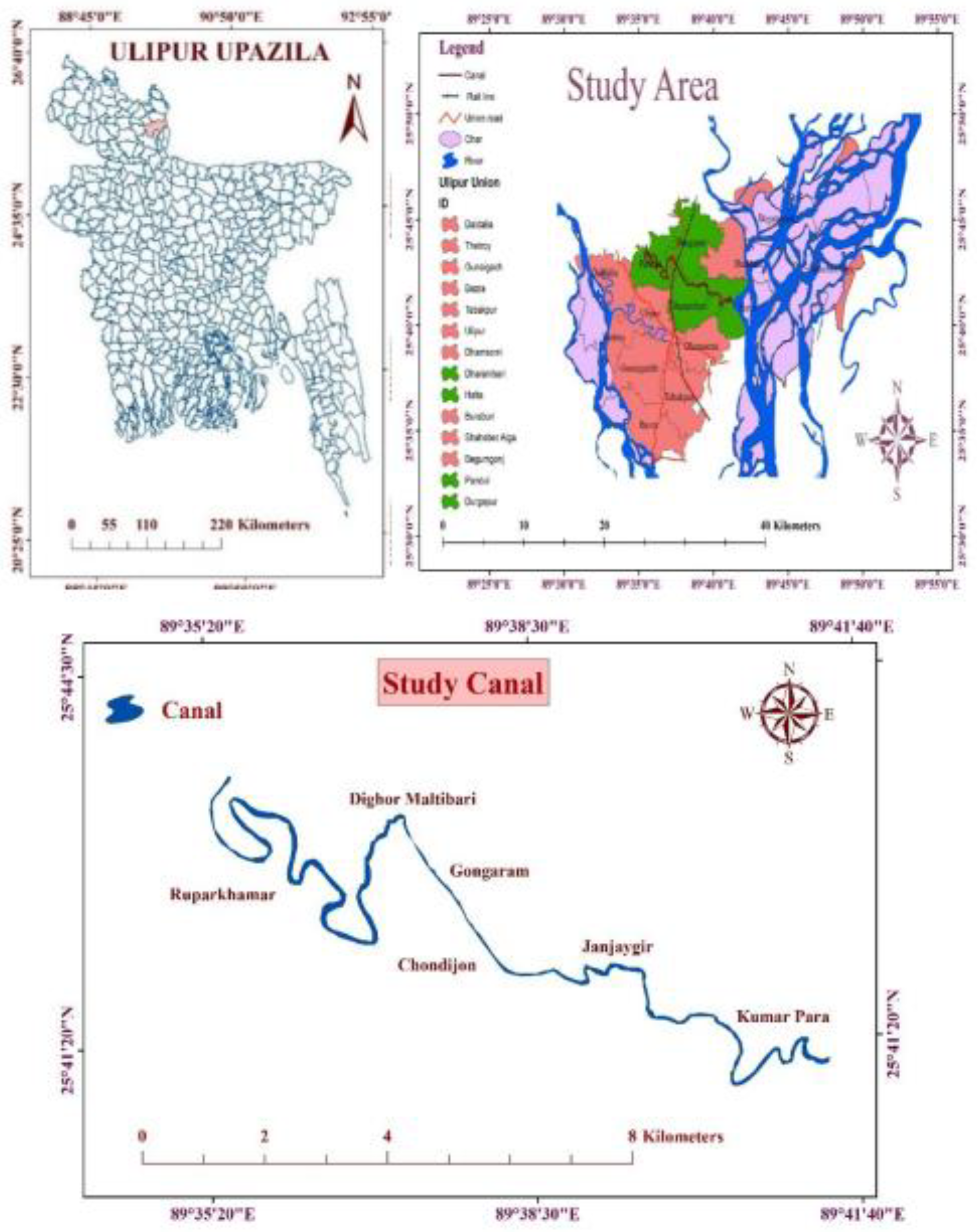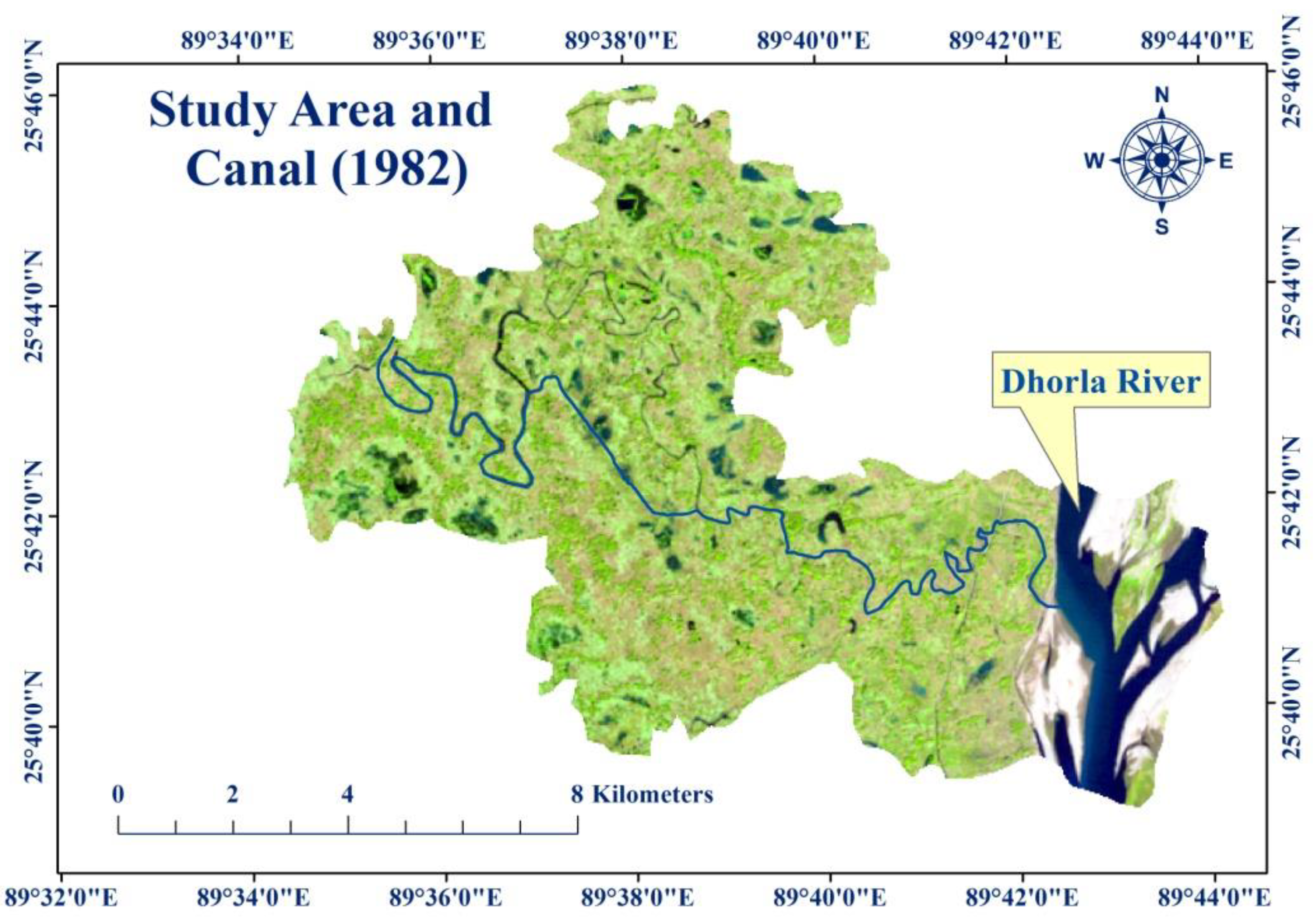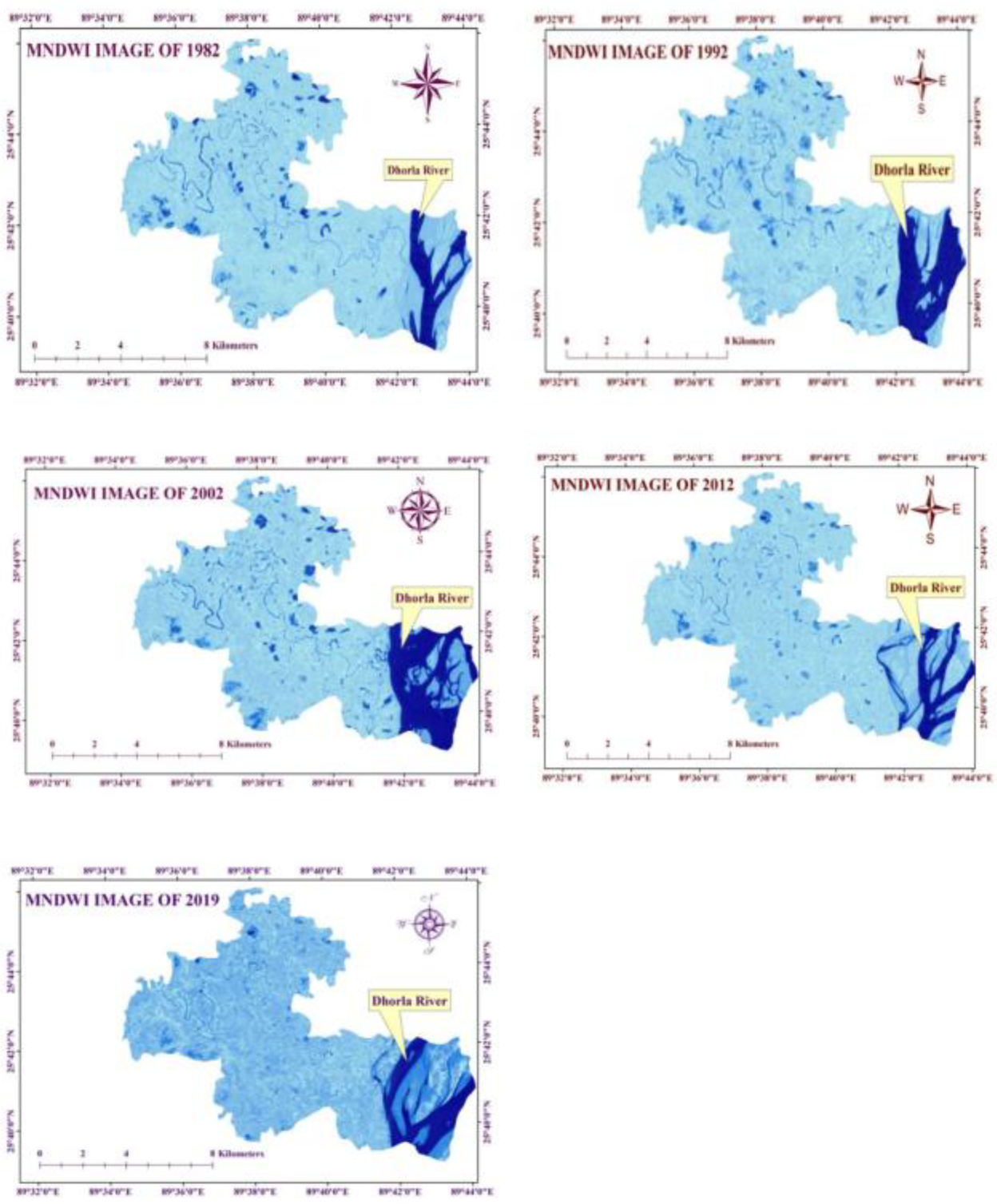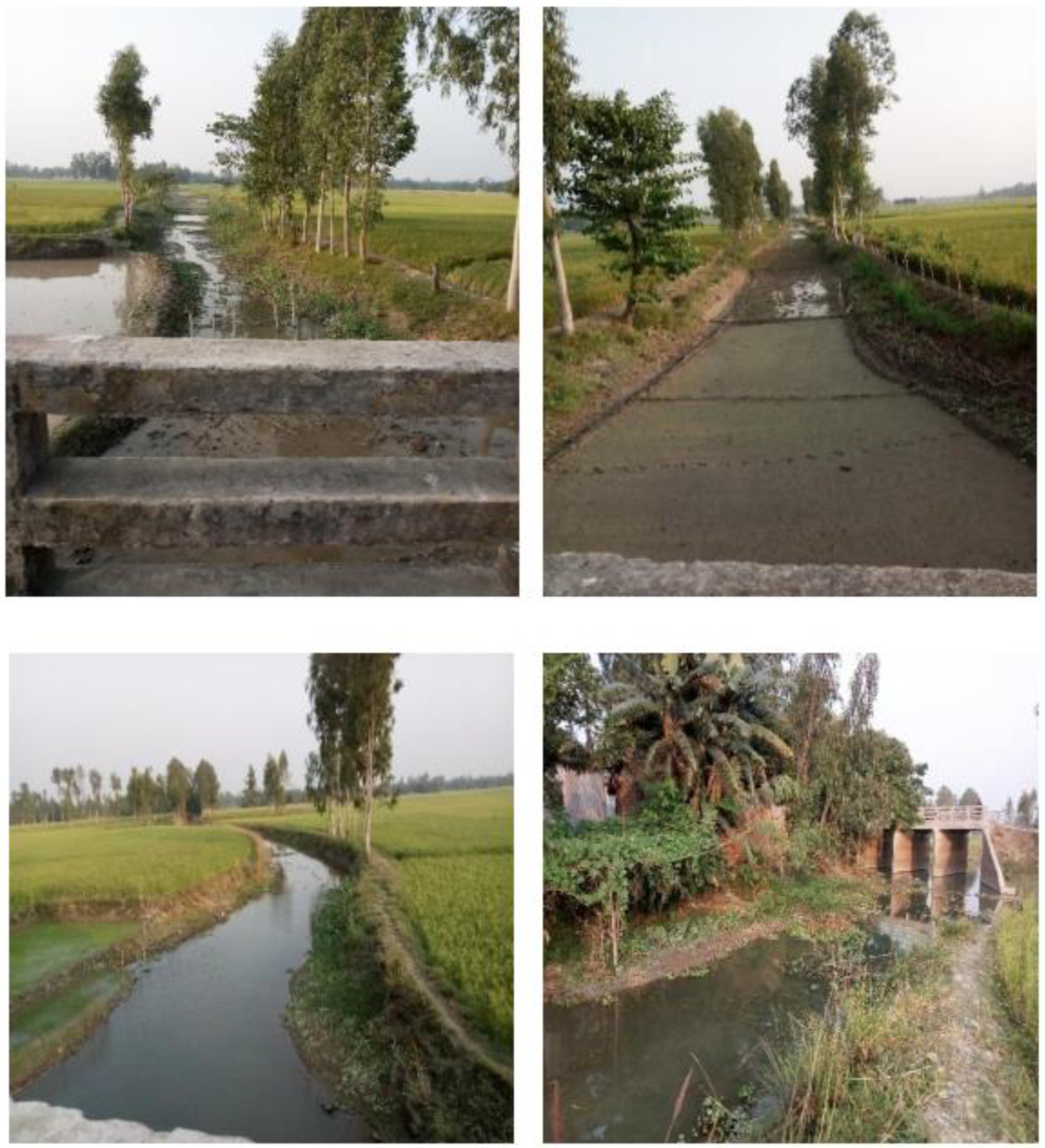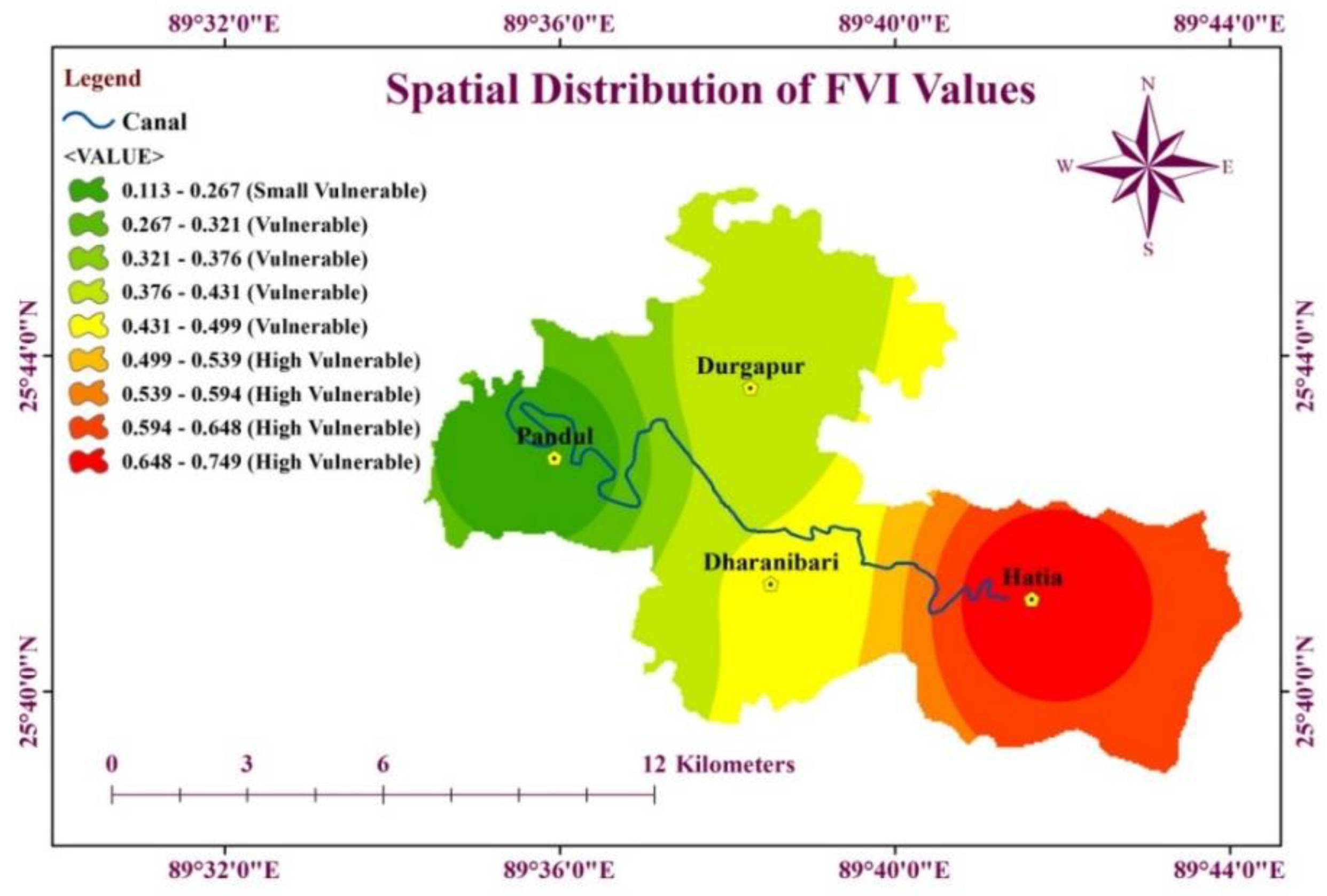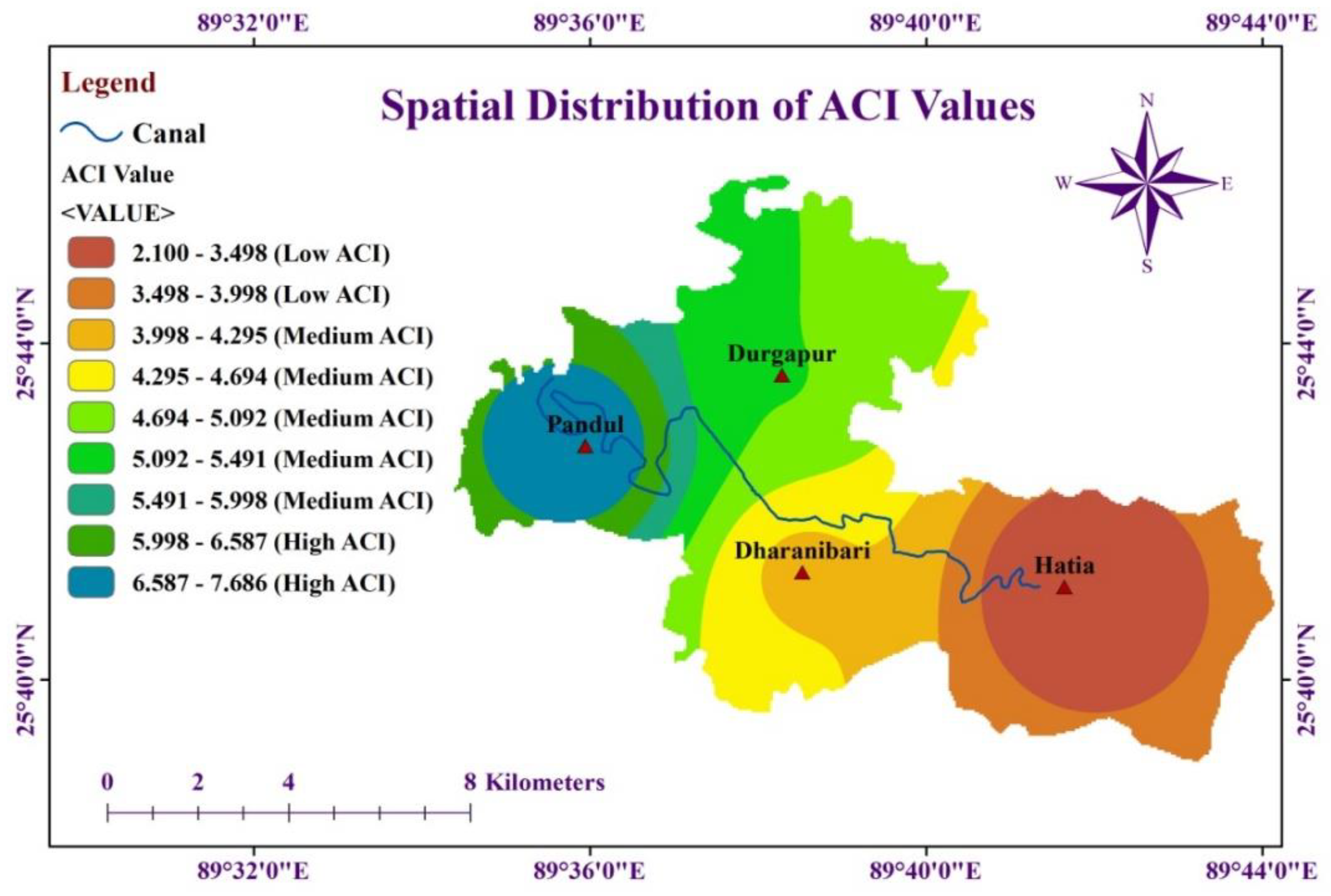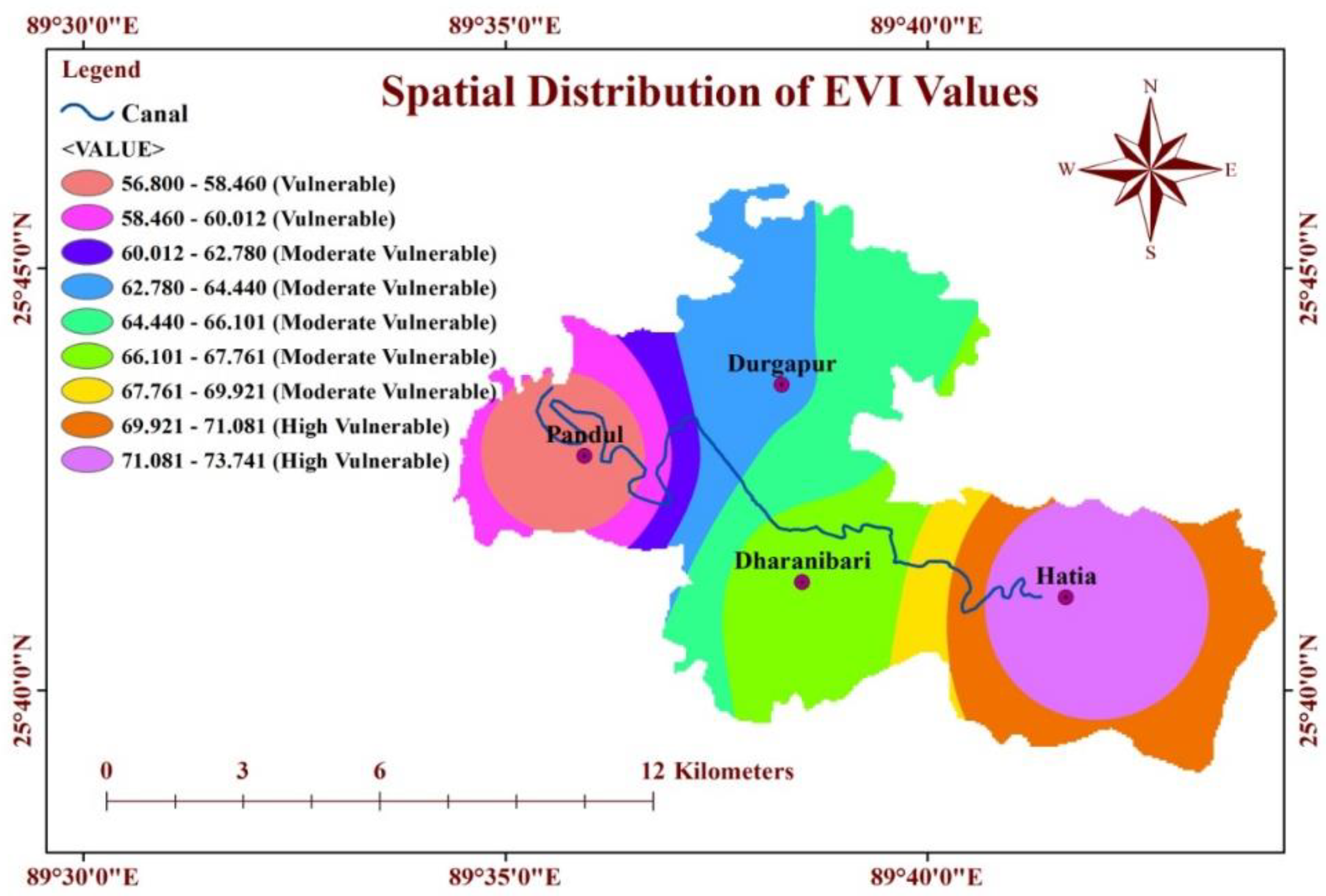1. Introduction
Rivers have traditionally been valued largely as water sources for cultivation and electricity. Rivers, on the other hand, provide a greater range of services that benefit the environment and people, as well as economies. Rivers and canals support economies, provide food for communities, contribute to flood regulation, and are considered the world’s most productive ecosystems [
1,
2,
3]. However, in recent years, the river, canal, and wetland areas have been decreasing due to human activities and natural events. The encroachment of rivers and canals increases the risk of flood and economic vulnerability by obstructing natural drainage, degrading water quality, impacting habitat and crop production, and destroying river-based economic activities [
4,
5,
6]. Constructing structures in the flood-prone areas causes a reduction in the flood storage capacity of flood plains, and such practices increase the risks to public safety. Recently, unplanned urbanization, construction activities, damming, and reduction in wetlands along with the encroachment of canals in the northern areas of Bangladesh have increased waterlogging, and various economic and agricultural losses. The impact of such phenomena is expected to worsen due to climate change.
Flooding is a challenge and a serious issue for the development of an area. Lack of drainage infrastructure, inadequate apertures, insufficient water storage, heavy rain, encroachment and obstruction in the drainage system, and backwater effects at outfalls are common causes of urban floods. The expansion of structures, roads, improved routes, railroads, utilities and other developments in natural regions such as river corridors, floodplains, lakes, wetlands, ponds, and the buffer zones around these places, is referred to as encroachment [
7,
8]. Moreover, encroachment intensifies impervious cover around bodies of water, thus leading to enhanced surface water runoff rate and volume, increased water temperature, sediment, and other pollutant loadings [
9]. Canals, also known as river channels, allow or help boats and ships to pass from one body of water to another. Furthermore, canals are useful sources of irrigation water and for other human purposes. The cumulative encroachment of canals that help with water flow during floods, irrigation, and transport of boats and ships can result in a persistent degradation of their services over time [
10]. The degree to which natural infiltration has been hampered, as well as the extent of encroachment and cumulative impacts of impermeable cover, can all contribute to the stream channel’s instability. Irrigation facilities are primarily what motivates farmers to excavate numerous canals. It also has a significant impact on the local, regional, and national economies [
2,
11]. Floods have serious impacts on the economy, livelihood, infrastructure, water supply, and drainage. In addition to preventing flooding and draining water, canals help to improve crop growth and quality and maintain landscapes, especially in areas that receive irregular or seasonal rainfall.
Bangladesh is a land of rivers. The rivers of the country have direct or indirect influences on the people of the country in many ways, like as a source of water for crop cultivation, fish, water transport, recreation, and business. The functional waterways and associated transportation sectors work as strong drivers of Bangladesh economy [
12]. Besides rivers, the canals in Bangladesh play an important role in the agricultural sector. Since 2000, Bangladesh’s rural sector, particularly agriculture, has been a significant driver of poverty reduction. Agriculture employs about 50% of all Bangladeshi employees, including 67% of those in rural regions, and about 87% of rural households rely on agriculture for at least part of their income. Due to irregular rainfall and drought events, crop production in many parts of Bangladesh, particularly in the northern part of the country, has been facing a serious problem. In order to sustain agriculture, the farmers in this region depend on canals. However, when the monsoons come, the rain from the Himalayas causes flooding in the north of Bangladesh. Previous studies have identified river and canal encroachment as one of the major causes of monsoon floods in the northern region [
13,
14,
15]. In short, the northern part of Bangladesh has been severely exposed to canal encroachment and its consequences. Moreover, this region is more vulnerable to climate change. Therefore, it is important to investigate the flooding and economic vulnerability caused by canal encroachment. This will enable us to identify the susceptible communities and provide support to the affected communities so that they can protect their livelihoods.
Floods affected about 350 million people around the world in 2016, and the number is expected to double by 2050. From 1988 to 2000, natural and man-made disasters in Central America and Asia caused a lot of damage and cost the economy USD 3.64 trillion. Between 2010 and 2020, nearly 3.6 billion people, or 56% of the world’s total population, were flooded. Balica et al. [
16] found that since 2010, 52 countries had lost a total of USD 2 billion in buildings, livestock, and crops due to flooding. The damage caused by floods in Southeast Asia, Africa, and North and South America in one year was more than
$5 billion. About 26,000 square km, or 10,000 square miles, or about 18% of Bangladesh, floods every year, killing more than 5000 people and destroying more than seven million homes. When floods are very bad, as they were in 1998, they can affect more than 75% of the country. This amount is 95% of the total amount that comes in each year. Most floods in Bangladesh are caused by unexpected rainfall in the southwestern mountains of India; more tropical storms; riverbeds drying out; and rivers with high discharge that can’t handle the water. The river and canal encroachment are also significantly responsible for flooding in Bangladesh. According to Egwumah et al. [
17], establishing settlements along the river bank through river encroachment was responsible for around 30% of the 4000 manatee deaths in the Florida River, USA. Dissanayake [
18] reported that the river encroachment in the upper Mahaweli River in Sri Lanka has intensified the stream water extremes and the frequency of flooding during the rainy season. According to Tyagi and Sahoo [
19], about 18.33% of agricultural land in Gorakhpur District, Uttar Pradesh, India suffered from conversion due to floodwater resulting from the encroachment of waterbodies. The impacts of the encroachment of country land, rivers, and canals and the various causes have been reported in various prior studies, including [
9,
20,
21,
22].
Several variables have been recognized as being responsible for canal encroachment. Recent studies have shown that assessment of the causes and impacts of floods has gained increasing attention. To assess the impacts of climatic change and different natural and man-made events on the local communities, the adaptive capacity index (ACI) can be used to provide a better understanding of the existing condition of the community. The flood vulnerability index (FVI) and ACI have been extensively applied in studies of the impact assessment of floods as well as flood management [
23,
24,
25,
26,
27]. FVI considers the social, physical, environmental, and economic vulnerability of an area to explore the impacts of flooding. ACI considers the methods for selecting, standardizing, and weighting indicators of events, and is as important as the characteristics of indicators have spatial variability [
27]. Although many studies have been conducted to assess the flood vulnerability of rivers [
28,
29,
30] and reservoirs, there is a lack of research using FVI to investigate flood vulnerability due to canal encroachment. Moreover, the integration of FVI and ACI has been less studied in flood vulnerability assessment. Most of the prior studies in Bangladesh focus on climate change vulnerability assessment and a limited number of studies focus on flood risk assessment [
31,
32,
33], and most of them illustrate a result on a large scale (regional or national). A truly microscale assessment integrating FVI, ACI, and economic vulnerability index (EVI) along with remote sensing technologies, is therefore still lacking. To the authors’ knowledge, no other studies have focused on how floods and the economy are affected by canal encroachment.
To fill the prior literature gap, this study intends to: (1) identify the past and present canal scenarios using satellite images; (2) assess the impacts of flooding due to canal encroachment using the integrated FVI and ACI; and (3) investigate the economic vulnerability using the EVI in the northern region of Bangladesh. This study will help policymakers to reduce flood and economic vulnerabilities impacted by channel encroachment and identify the most appropriate course of action.
3. Results
3.1. Past and Present Status Analysis
To analyze the past and present status of the canal, in this study we used five satellite images from different years. The interval of 10 years was 10. As the canal was excavated at the end of 1981, the 1982 image was taken for analysis. According to the year interval after 2012, the next year would be 2022, but as it is 2019, we used images from 2019. In this study, we used images from the winter season, because during the winter season, we can obtain the actual width of rivers and canals.
After using the MNDWI, the image of the year 1982 shows a clear picture of the study canal. Through this index, the water body is highlighted in blue for easy understanding, and other land areas are represented in light blue. The canal was 90 feet wide in 1982 and there was no encroachment. Thus, a thin clear structure of the canal was observed in
Figure 3.
Figure 3 represents the image of 1992, and the blue color represents the water body. From the color combination, a thin canal similar to the 1982 image is displayed in
Figure 3. From this image, it is clear that the canal was in good condition. After the excavation of the canal, no encroachment occurred in the year 1992.
The MNDWI image of 2002 shows the canal condition in the year 2002 (
Figure 3). Twenty years after the excavation, the middle part of the canal was not obvious in the image. This means the middle part was at the starting point of encroachment. In 2002, the population size of the area surrounding the Bamni canal increased. Consequently, more people need more places to live and more food to consume. Therefore, the local people started to grab the open spaces alongside the canal for building houses and for agricultural purposes. People started to build houses beside the canal due to the availability of fish. But these activities were hampering the canal’s conditions and function.
A very thin canal was observed, but the ending part of the canal had almost disappeared. The width of the canal was too small to be captured by the satellite.
Figure 3 is the image taken in 2012, and the population was more than that in 2002. Hence, it can be easily seen that the local people gradually started to occupy the land around the canal. The locals started to build houses on the banks of the canal. After 30 years of canal excavation, no measure was taken to dredge the canal. Thus, the canal lost its actual depth and width. Consequently, the water holding capacity of the canal was significantly reduced and the surrounded area became prone to floods during the rainy season. The encroachment began after 2002 and has steadily increased, as evidenced by the result obtained from the 2012 image.
Figure 3 represents the MNDWI image of 2019 where the starting point of the canal in the Pandul union appears only. However, the middle and end parts are missing in the image of the Dharanibari, Durgapur, and Hatia unions. The canal was not fully missing, but the width was so narrow that the satellite could not capture it.
After the analysis of the 2019 MNDWI image, it is clear that the encroachment rate has significantly increased (
Figure 4). The same canal that had a thin structure in the 1982 image has almost completely disappeared in the satellite image of 2019. The canal was diminishing, and the width is just about 6 feet now. This was why satellite images from 2019 could not capture the canal. These results clearly suggest that encroachment decreases the width of the canal. Moreover, the lack of proper reservation of canals is one of the major reasons for the encroachment. This is not only the scenario of one canal in this Upazila; this is the scenario for almost every canal in Bangladesh. The images below show the actual present condition of the canal used in this study.
3.2. Flood Vulnerability Index (FVI) Assessment
Table 4 represents the FVI values of the Dharanibari union that explain the vulnerability of this union to floods. Here, the total FVI comes from the summation of four types of vulnerability including social, economic, environmental and physical. This table shows a 0.305 value of economic vulnerability, a 0.006 value of social vulnerability, a 0.016 value of environmental vulnerability, and a 0.111 value of physical vulnerability. Dharanibari union was vulnerable to floods with a total FVI value of 0.438. This means this union has a moderate vulnerability to floods. Every year, this union experiences moderate to severe flooding. Dharanibari union is the most vulnerable among four unions due to high population growth and less urbanization. This indicates a low value of social and environmental indicators in the Dharnibari union.
The total FVI value of the Durgapur union was 0.404, which also indicates that this union is vulnerable to flooding similar to the Dharanibari union.
Table 4 also shows a social vulnerability of 0.021, an environmental vulnerability of 0.028, an economic vulnerability of 0.192 and a physical vulnerability of 0.163 for the Durgapur union. The Durgapur union is also vulnerable due to high population growth and low infrastructure facility according to last population census report in 2011.
Table 4 represents the FVI values of the Pandul union. The total FVI value for Pandul was 0.213, indicating a small vulnerability to floods. The Pandul union is situated far from the river, and this is the reason for less vulnerability. For the Pandul union, the economic vulnerability is 0.099 and the physical vulnerability is 0.078. This union experiences floods during the rainy season as the canal’s depth is significantly less than before and the water holding capacity of the canal has also significantly decreased.
Hatia is the union that is adjacent to the Brahmaputra River. This river is the main cause of the flood vulnerability of this union.
Table 4 represents the FVI values of the Hatia union. The economic and physical vulnerability of Hatia Union were 0.315 and 0.345, respectively. The total FVI of the Hatia union was 0.703, which indicates high vulnerability to floods. Almost every year, this union becomes flooded. Historically, this canal helped to efficiently drain flood water, but nowadays, the union is flooded for 3/4 of the rainy season.
The spatial distribution of FVI values of the four studied unions in Ulipur upazila is shown in
Figure 5. The figure indicates the Hatia union has the highest vulnerability to floods among the four unions. Hatia is situated in the north-eastern part of the upazila that is adjacent to the Dhorla River, and for this reason, Hatia is more vulnerable to floods. This canal encroachment also increases the flood vulnerability of the Hatia union. On the other hand, Pandul has a small vulnerability to flooding according to the spatial distribution.
3.3. Adaptive Capacity Index (ACI) Assessment
Among the four studied areas, after analyzing surveyed data using the modified ACI model of Sposito et al. [
26], it was found that the highest adaptive capacity was at the Pandul union, and the lowest capacity was found at the Hatia union (
Table 5). It is worth noting that capacity and vulnerability are reversed in nature, but these results have been accomplished in a qualitative way. Thus, there can be fluctuations in outcomes. However, in this study, vulnerability and capacity are the opposite conditions. According to the FVI values, Hatia union is highly vulnerable to floods, and according to the ACI values, Hatia had the lowest value of 3.1. A low ACI value indicates low adaptive capacity. As Hatia union has low adaptive capacity, this led to the union’s high flood vulnerability. Therefore, both the indexes fit with each other in this study. On the other hand, Pandul had a 6.7 ACI value, which denotes high adaptive capacity. Based on the FVI, Pandul had a small vulnerability to floods. Hence, in this intense situation, both indexes were positively correlated with each other. The canal used in this study passes through these four unions, and the canal was excavated for the benefit of local people. However, the results are different now. Human activities, such as canal encroachment, slowed down the normal flow of rainwater, which led to more and bigger floods in the study area in recent years.
Calculated ACI values are presented in
Figure 6 through spatial distribution.
Figure 6 explains the adaptive capacity of the studied unions to floods. According to this figure, Pandul has a high ACI value range of 6.587–7.686, which means this union has a better adaptive capacity to flood than the other unions. On the other hand, the Hatia union has the lowest ACI value, ranging from 2.100 to 3.498. This denotes the vulnerability of this union to flood impacts. According to this figure, Durgapur and Dharanibari unions have medium adaptive capacity to flood. According to this figure, the ACI values are within 5.092–5.491 and 3.998–4.295.
3.4. Economic Vulnerability Index (EVI) Assessment
Table 6 represents the Economic Vulnerability Index (EVI) values that denote how the unions are economically vulnerable. Hatia has the highest EVI value (72.8) among the unions, indicating that this union is economically highly vulnerable to floods, according to the table. On the other hand, Pandul has the lowest EVI value (57.8) among the unions that indicate Pandul is economically vulnerable to flooding. An EVI of 50 describes a general condition where the vulnerability is neither high nor low. Dharanibari and Durgapur unions have moderate economic vulnerability as their EVI values are 67.3 and 64.4, respectively.
Economic vulnerability is directly and indirectly related to the canal encroachments. As the canal is encroached upon, flood frequency and severity also increase. Every year, floods damage crops, houses, roads, and infrastructure. Repairing these infrastructures need money, and damaged crops create a loss in production. Therefore, the farmer does not have much money to repair the flood damage. The depth of the canal decreases; consequently, its water holding capacity also decreases. In the past, this canal was a major source of fish for the local people, but now only a small number of fish can be found seasonally, mostly in the rainy season. Thus, the local people must buy fish from the market. Hence, canal encroachment increases the daily budget. In the past, the locals could get fish for free from the canal, and as there were lots of fish in the canal, the market rate of fish was also significantly lower. Most of the local people do not have much money to spend on fish at such high prices. Many people face a lack of protein in their daily diet since fish is a major source of protein in their diet. The lack of protein results in diseases, and thus people must spend more money on health care. Hence, encroachment has many direct and indirect negative consequences.
Canal encroachment is always a negative aspect, but some argue that using encroached land for agricultural purposes or for urbanization can bring economic resilience. Nonetheless, the risk associated with encroachment far outweighs the benefits. The water holding capacity of the canal has significantly decreased. This means that the farmer must spend more money on groundwater irrigation. Moreover, they may lose their crops each year due to flood events. But if the canal was not encroached, the flood water would have quickly flowed to the river, thus the crops would have survived. Therefore, there is no overall economic benefit from encroachment, but there is more economic loss. One may argue that, through encroachment, the cultivable land has increased in that area, and this will lead to more production. Even though more land is created, that does not equate to more production since every year most of the crops are lost to floods.
The EVI values of four unions are shown in
Figure 7. According to this figure, Durgapur and Dharanibari unions have moderate economic vulnerability as the EVI values of these unions ranged between 62.780 and 64.440 and 66.101 and 67.761 respectively. On the other hand, Pandul has an EVI value within the 56.800–58.460 range that indicates the vulnerable economic condition of this union. Moreover, the Hatia union is in the most economically vulnerable condition among the four unions as the EVI value of Hatia is within the range of 71.081–73.741. This union is the most affected of the unions due to encroachment. Encroachment affects the economy, social status, infrastructure, as well as the environment of these unions.
Figure 7 also shows the EVI values that show how economically vulnerable the unions are.
Table 7 represents the correlations among the three indexes used in this study. According to this table, ACI has a negative relationship with FVI and EVI. Studies have shown that with increasing adaptive capacity, flood vulnerability and economic vulnerability will be reduced. The results also show that the FVI was significant at the 0.05 level, while the EVI was significant at the 0.01 level (2-tailed). Our findings also show a positive relationship between FVI and EVI. If the vulnerability of any area increases, economic vulnerability will also increase. Furthermore, adaptive capacity will decrease, and ACI is significant at the 0.05 level (2-tailed).
4. Discussion
In recent years, the intensity and frequency of different types of hazardous events have increased, as have their adverse environmental, social, and economic impacts. The preventive and mitigative study of flood events supported by an investigation of the causes of flooding at microscale provides the evidence for disaster risk-based decision making [
47]. The study of different types of vulnerability in any geographical location is essential to reduce economic loss, avoid the loss of wealth and, more importantly, save human lives during disasters [
48]. Most of the coastal and low-lying areas of developing countries like Bangladesh are more vulnerable to flood risks [
49]. This study provides insights into flood and economic vulnerability due to canal encroachment in the northern areas of Bangladesh, based on the integration of the flood vulnerability index, adaptive capacity index, and economic vulnerability index. The results have been compared with the vulnerability in different unions.
Because of the increased flood hazard, better approaches must be established to help decision-making in flood risk management. The FVI is a tool that focuses on indicators. The FVI has been thoroughly evaluated with regard to all components of a flood disaster that are most likely to be affected: social, economic, environmental, and physical. The FVI tests the vulnerability level for each factor (exposure, susceptibility, and resilience). The main reason is that a variety of factors, including social, economic, environmental, physical, and even political factors, are responsible for differences between different units related to different indicators. Since this upazila is densely populated, it is highly prone to flooding. Exposure, susceptibility, and resilience are three factors having impacts on the calculation of vulnerability [
50]. They make a little difference between different units related to different indicators. Illegal construction over a canal, unauthorized land filling, and solid waste dumping are the other reasons that affect the flooding. The FVI has been evaluated holistically, taking into account all dimensions that are most likely to be impacted by a flood disaster in the study area.
The spatial analysis to evaluate the historical canal encroachment pattern is useful for sustainable spatial planning by adopting the necessary measures to restore the canal width. The satellite image analysis shows that, since 2002, the canal encroachment has steadily increased, and by 2019, the canal width in the three unions has significantly declined. During the study period, the canal width was reduced from 90 feet to 6 feet due to the encroachment of the river by constructing houses and other infrastructure. This significantly reduced natural water flows through the canals and water velocity, resulting in waterlogging problems during the monsoon season and a water crisis during the summer and winter seasons. According to Zhang et al. [
51], morphological changes in the channel resulting from siltation or encroachment will result in changes in the channel’s elevation and slope. The study found that these changes in river morphology led to a degradation of river health and had substantial impacts on flood control. Prior studies have shown that the waterbodies in the urban and rural areas of Bangladesh have been going through a rapid land-use transformation in the last few decades [
52,
53,
54]. According to Mahmood et al. [
6], encroachment and landfills lead to the narrowing of rivers in Bangladesh, and in recent years, this encroachment rate has increased. This made floods more likely and made the problem of waterlogging worse (in time and speed) in both cities and rural parts of the country.
According to Chowdhury et al. [
7], about 56.10% of the Buriganga River in Dhaka city has been encroached upon to build infrastructure from 2001 to 2014. Rapid population growth, agriculture, human settlement, cash cropping, shifting cultivation, and unplanned infrastructure development were identified as the primary causes of encroachment in the study, which is consistent with previous research [
51,
54,
55,
56]. As a result, when a large amount of water flows in the canals and rivers in Bangladesh during the monsoon, it causes flooding and has serious consequences for the livelihood and economy of the affected people as well as the country [
28,
57,
58]. Moreover, researchers have identified the primary reason for waterlogging in the major cities in Bangladesh as the shrinkage of natural drains due to encroachment [
59]. According to Bigi et al. [
47], the reduction of river width and siltation are the major drivers of flood risks in the river basins, which is congruent with our study.
Figure 3 and
Figure 5 show that the FVI value was optimum (highly vulnerable) in the eastern part of the study area where canal encroachment occurred most, and the FVI value was minimum where canal encroachment occurred comparatively less.
The vulnerability of floods to any geographical area depends on the social, economic, physical, and environmental vulnerabilities of that area [
58,
60,
61]. This study used these factors in FVI and utilized the ACI to illustrate a realistic picture of the impacts of floods in the study area. The FVI values of 0.438 in the Dharanibari union and 0.404 in the Durgapur union indicate that these two unions are moderately exposed to flooding, while the FVI value of 0.703 in the Hatia union indicates high vulnerability to floods. The FVI shows that all the studied unions exhibited a higher economic and physical vulnerability, which led to an increase in the vulnerability of the unions. Fatemi et al. [
62] demonstrated that physical vulnerabilities play a significant role in flood damage in Dhaka’s peri-urban areas. Ahmadi et al. [
63] also identified economic and physical vulnerability as having significant influences on flood impacts in Iran, and the result of this study is similar to our findings. Though the results of all the four vulnerabilities (social, economic, physical, and environmental) showed a spatial variation, it clearly signifies the need for consideration of all these parameters separately in flood vulnerability assessment. The outcome of the ACI shows the inverse outcome of FVI. Hatia union is highly vulnerable to floods, and according to the ACI values, Hatia had the lowest value of 3.1, which implies that the Hatia union is highly exposed to flood impacts due to canal encroachment in the northern region of Bangladesh. Areas with lower adaptation capacity are highly vulnerable to climate change. Talukdar et al. [
64] reported that the northwestern districts of Bangladesh are more susceptible to flooding. The overall flood impact assessment in the study area shows that steps need to be taken to increase adaptation capacity so that flood vulnerability and exposure can be reduced.
Floods have a significant impact on local and national economic performance. Floods’ economic vulnerability assessment provides powerful data for policy planning and risk management strategies [
63]. This study found an unequal pattern of flood exposure and economic vulnerability across different unions, which contributes to differences in economic vulnerability. The findings show that the canal encroachment increased the frequency and damaging capacity of flooding, which increased the damage costs and decreased crop production and fish cultivation in the study area. The direct and indirect economic impacts of canal encroachment also cause health impacts such as protein deficiency due to lack of money to purchase protein rich products. Näschen et al. [
65] showed that the decrease of water bodies has severe impacts on agriculture, fish cultivation, and the local as well as national economy by reducing food production capacity. Previous research has found that the loss of wetlands and water bodies is now posing a challenge to ensuring food security [
31,
66,
67,
68]. All these findings of prior research are congruent with our findings. The EVI ranged between 56.80 and 73.74 at a 0.01 level of significance, which implies that the canal encroachment has moderate to high adverse economic impacts in the studied unions of the northern region of Bangladesh. Moreover, farmers do not get sufficient water for cultivation in summer and winter due to the insufficient flow of water from the rivers through canals. Such events influence drought events and cause economic losses by reducing crop production. Mohsenipour et al. [
69] reported that recent climatic changes and man-made reasons have increased droughts in the riverine country of Bangladesh, especially in the northwestern region of the country. Islam et al. [
53] found that climate change in the northern region of Bangladesh greatly affected the crop production capacity of this region, and Zinat et al. [
70] reported that drought events reduced the production of Boro rice in the western region of the country. A study by Mahmood et al. [
6] found that about 35.51% of the local people have suffered economic losses due to the encroachment of the Buriganga River in Bangladesh. A similar economic loss has been reported by Egwumah et al. [
17] in Nigeria.
Although river and canal encroachment has some positive effects, such as infrastructural development (roads, housing, settlements) and providing opportunities for economic development, this study found serious adverse impacts of canal encroachment on flooding, as well as social, physical, environmental, and economic vulnerabilities. The overall study demonstrates the critical scenario of social, physical, environmental, and economic conditions in the studied area due to canal encroachment. So, a detailed microscale assessment of the effects of canal encroachment will help planners, researchers, and policymakers better understand and use the landscape in a way that is sustainable, taking into account what could happen in the future.
